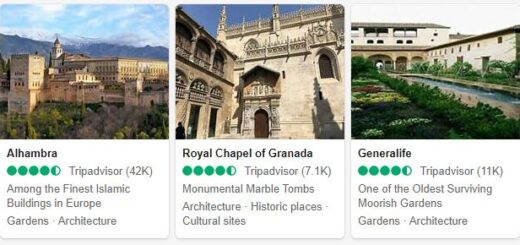Sights of Rimini, Italy
The historic city of Rimini is located in Italy on the Adriatic Sea. Rimini has held an important place in the Emilia-Romagna region since Roman times. At the time it was called ‘Colonia Ariminum’. Rimini was easily accessible from the city of Rome via the Via Flaminia. And later, Rimini was mainly passed by persons on their way to Ravenna, a city in which the seat of the Byzantine Exarch was located.
Today, Rimini is a city where ancient culture and modern entertainment go hand in hand. As a young people destination you can enjoy sun, sea, beach and great nightlife in Rimini. But the city clearly has much more to offer than this. The many archaeological sites have left interesting sights. The theater and the university also occupy an important place in Rimini. A walk through the center quickly takes you through nostalgic and sometimes colorful streets and squares to various beautiful places in the city, waiting to be discovered.
Top 10 sights of Rimini
#1. The beach
According to Sunglasseswill.com, the main reason for tourists to come to Rimini is the beach. With a total length of no less than 15 kilometers, it is a good place to stay here in the summer months at the many numbered beach clubs. Rimini is considered the largest seaside resort in Italy.
#2. Arco d’Augusto
The Roman Arco d’Augusto was built long ago as a city gate on the Via Flaminia in Rimini. The gate was dedicated to Emperor Augustus, the founder of the Roman Empire. In the upper left and right corners you see a shield with four Roman mythological gods on it: Apollo, god of the fine arts, music and spirituality, among other things. Jupiter, god of the sky and thunder. Neptune, god of the sea. And Roma the goddess and patroness of the city of Rome. The arch in the Arco d’Augusto is so large that it was never possible to realize a gate in it at the time. The battlements at the top were placed later in the tenth century. Arco d’Augusto is a very well preserved monument and a symbol of the city of Rimini.
#3. Forum Romano
The archaeological site of Foro Romano in Rimini has several details from the past, each with a special story. It was the most central and important economic crossroads of the Italian region of Emilia-Romagna, located between Cardus Maximus and Decumanus Maximus streets. Today you can admire all kinds of details with your own eyes that have been exposed during various excavations. Thanks to the efforts of historians such as Luigi Tonini, we can enjoy a Roman amphitheater from the second century. The Surgeon, a living quarters discovered in the basement of Piazza Ferrari. And there are also remains of old stone roads.
#4. Ponte di Tiberio
The marble monumental bridge Ponte di Tiberio is located on the eastern side of Parco XXV Aprile. The Ponte di Tiberio was built as early as the first century to provide a connection across the Marecchia River. On one side you enter Viale Tiberio and on the other side Corso d’Augusto. It is also seen as the starting point for the ancient Roman roads Via Emilia and Via Popilia. The bridge is over seventy meters long and consists of five arches.
#5. Anfiteatro
The Roman amphitheater in Rimini is unfortunately not much more than a ruin. It was once a colossal theater where at least ten thousand people played all kinds of games, competitions and bloody battles. The location not far from the sea must also have provided several attractive views. The ‘Anfiteatro’ of Rimini was probably built in the second century.
#6. Porta Montanara
In the center of the city, not far from the Arco d’Augusto, is the Porta Montanara gate. This smaller entrance gate is also nicknamed ‘Sant’Andrea’. Porta Montanara was built in the first century to provide pedestrian access to the city from the Via Arretina. At that time, the gate consisted of two arches. One arch was intended as an entrance and the other as an exit. Unfortunately, the Second World War also wreaked havoc in Rimini and part of it was unfortunately lost.
#7. Domus del Chirurgo
The living quarters ‘Domus del Chirurgo’, built in the second century, were discovered during excavations in 1989 in the basement of Piazza Ferrari. The more than seven hundred square meters living quarters most likely belonged to the Greek physician ‘Eutyches’. The clues to this come from the various ancient details that have since been uncovered. Think of mosaic floors and inscriptions in common areas and in the living rooms and bedrooms. But various objects, furniture and tools were also found. Much of this is exhibited in the city museum ‘Museo della città di Rimini’.
#8. Nightlife
Rimini is known as an excellent destination for youth holidays. That is because, in addition to the immensely large sandy beach, the city also offers many options for going out. Scattered throughout the city you will find various clubs and bars where you can go wild until late at night. The largest discotheque is Baia Imperiale, where more than 15,000 party visitors can be found on the busiest days during the high season.
#9. Tempio Malatestiano
The exceptionally beautiful fifteenth century church Tempio Malatestiano is an important monument of the Italian city of Rimini. For example, the church, which is often referred to as ‘Il Duomo’, is most likely the first eclectic building of classical architecture. Various Italian artists such as Piero della Francesca, Leon Battista Alberti, Agostino di Duccio and Matteo de ‘Pasti worked on the construction and decoration. The appearance of the Tempio Malatestiano is largely due to Leon Battista Alberti, lover of classical architecture.
#10. Castel Sismondo
In the immediate vicinity of Piazza Cavour and the nearby Teatro Galli is the old palace Castel Sismondo. In the fifteenth century, Sigismondo Pandolfo Maletesta, an influential descendant of the Malatesta family, ordered the construction of a castle. The first stones of Castel Sismondo were laid in the year 1437. Although several architects participated in this construction project, it was revealed that Sigismondo designed it himself. Thirty-one years later he died in his beloved Castel Sismondo. Today the castle is used for cultural events.



